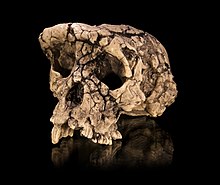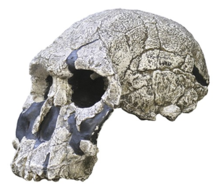Hominini
| Hominini Temporal range:
| |
|---|---|

| |
| Two hominins: A human holding a chimpanzee (Ham the chimp) | |
| Scientific classification | |
| Domain: | Eukaryota |
| Kingdom: | Animalia |
| Phylum: | Chordata |
| Class: | Mammalia |
| Order: | Primates |
| Suborder: | Haplorhini |
| Infraorder: | Simiiformes |
| Family: | Hominidae |
| Subfamily: | Homininae |
| Tribe: | Hominini Arambourg, 1948[1] |
| Type genus | |
| Homo Linnaeus, 1758
| |
| Genera | |
| |
The Hominini form a taxonomic tribe of the subfamily Homininae ("hominines"). Hominini includes the extant genera Homo (humans) and Pan (chimpanzees and bonobos) and in standard usage excludes the genus Gorilla (gorillas).
The term was originally introduced by Camille Arambourg (1948). Arambourg combined the categories of Hominina and Simiina due to Gray (1825) into his new subtribe.
Traditionally,
Humans are the only extant species in the Australopithecine branch (subtribe), which also contains many extinct close relatives of humans.
Terminology and definition
Concerning membership, when Hominini is taken to exclude Pan, Panini ("panins")[4] may refer to the tribe containing Pan as its only genus.[5][6] Or perhaps place Pan with other dryopithecine genera, making the whole tribe or subtribe of Panini or Panina together. Minority dissenting nomenclatures include Gorilla in Hominini and Pan in Homo (Goodman et al. 1998), or both Pan and Gorilla in Homo (Watson et al. 2001).
By convention, the adjectival term "hominin" (or nominalized "hominins") refers to the tribe Hominini, whereas the members of the subtribe Hominina (and thus all archaic human species) are referred to as "homininan" ("homininans").
The alternative convention uses "hominin" to exclude members of Panina: for Homo; or for human and australopithecine species. This alternative convention is referenced in e.g. Coyne (2009)
Cladogram
This
Genetic analysis combined with fossil evidence indicates that hominoids diverged from the Old World monkeys about 25 million years ago (Mya), near the Oligocene-Miocene boundary.[14] The most recent common ancestors (MRCA) of the subfamilies Homininae and Ponginae lived about 15 million years ago. The best-known fossil genus of Ponginae is Sivapithecus, consisting of several species from 12.5 million to 8.5 million years ago. It differs from orangutans in dentition and postcranial morphology.[15] In the following cladogram, the approximate time the clades radiated newer clades is indicated in millions of years ago (Mya).
Hominoidea (20.4 Mya)
|
| ||||||||||||||||||||||||||||||||||||||||||||||||
Evolutionary history
Both Sahelanthropus and Orrorin existed during the estimated duration of the ancestral chimpanzee–human speciation events, within the range of eight to four million years ago (Mya). Very few fossil specimens have been found that can be considered directly ancestral to genus Pan. News of the first fossil chimpanzee, found in Kenya, was published in 2005. However, it is dated to very recent times—between 545 and 284 thousand years ago.[16] The divergence of a "proto-human" or "pre-human" lineage separate from Pan appears to have been a process of complex speciation-hybridization rather than a clean split, taking place over the period of anywhere between 13 Mya (close to the age of the tribe Hominini itself) and some 4 Mya. Different chromosomes appear to have split at different times, with broad-scale hybridization activity occurring between the two emerging lineages as late as the period 6.3 to 5.4 Mya, according to Patterson et al. (2006),[17] This research group noted that one hypothetical late hybridization period was based in particular on the similarity of X chromosomes in the proto-humans and stem chimpanzees, suggesting that the final divergence was even as recent as 4 Mya. Wakeley (2008) rejected these hypotheses; he suggested alternative explanations, including selection pressure on the X chromosome in the ancestral populations prior to the chimpanzee–human last common ancestor (CHLCA).[18]
Most
- probability of being ancestral to Homo, and
- whether they are more closely related to Homo than to any other living primate—two traits that could identify them as hominins.
Some, including Paranthropus, Ardipithecus, and Australopithecus, are broadly thought to be ancestral and closely related to Homo;[26] others, especially earlier genera, including Sahelanthropus (and perhaps Orrorin), are supported by one community of scientists but doubted by another.[27][28]
List of known hominin species
Extant species are in bold.
- Sahelanthropus tchadensis
- Orrorin tugenensis
- Ardipithecus kadabba
- Ardipithecus ramidus
- Australopithecus anamensis
- Australopithecus afarensis
- Australopithecus deyiremeda
- Australopithecus garhi
- Kenyanthropus platyops
- Australopithecus africanus
- Australopithecus sediba
- Paranthropus aethiopicus
- Paranthropus boisei
- Paranthropus robustus
- Pan troglodytes
- Pan paniscus
- Homo habilis
- Homo rudolfensis
- Homo ergaster
- Homo erectus
- Homo antecessor
- Homo heidelbergensis
- Homo naledi
- Homo neanderthalensis
- Homo denisova
- Homo sapiens
- Homo floresiensis
- Homo luzonensis


See also
- History of hominoid taxonomy
- Human evolution
- Human taxonomy
- Human timeline
- List of human evolution fossils
References
- S2CID 84553920.
- PMID 28531170.
- ^ great apestogether in a distinct group from humans. For this reason, many researchers now place all species of great ape and human within a single family, Hominidae – making them all proper 'hominids'.
- .
- ^ ISBN 978-1-4262-0606-1.
- ^ ISBN 978-0-14-197531-3.
Conventionally, taxonomists now refer to the great ape family (including humans) as 'hominids', while all members of the lineage leading to modern humans that arose after the split with the [Homo-Pan] LCA are referred to as 'hominins'. The older literature used the terms hominoids and hominids respectively.
- S2CID 203884394.
- ISBN 978-1-118-52475-6.
- ProQuest 1038821782.
- PMID 8673284.
- ^ ISBN 978-0-670-02053-9.
Anthropologists apply the term hominin to all the species on the "human" side of our family tree after it split from the branch that became modern chimps." (p.197)
- Wikidata Q24646554.
- PMID 10999270.
Thus human evolution is the study of the lineage, or clade, comprising species more closely related to modern humans than to chimpanzees. Its stem species is the so-called 'common hominin ancestor', and its only extant member is Homo sapiens. This clade contains all the species more closely related to modern humans than to any other living primate. Until recently, these species were all subsumed into a family, Hominidae, but this group is now more usually recognised as a tribe, the Hominini.
- ^ Balter, Michael (15 May 2013). "Fossils May Pinpoint Critical Split Between Apes and Monkeys". Science.
- ^ Taylor, C. (2011). "Old men of the woods". Palaeos. Retrieved 4 April 2013.
- S2CID 4423286.
- S2CID 2325560.
- S2CID 4367089.
Patterson et al. suggest that the apparently short divergence time between humans and chimpanzees on the X chromosome is explained by a massive interspecific hybridization event in the ancestry of these two species. However, Patterson et al. do not statistically test their own null model of simple speciation before concluding that speciation was complex, and—even if the null model could be rejected—they do not consider other explanations of a short divergence time on the X chromosome. These include natural selection on the X chromosome in the common ancestor of humans and chimpanzees, changes in the ratio of male-to-female mutation rates over time, and less extreme versions of divergence with gene flow. I therefore believe that their claim of hybridization is unwarranted.
- OCLC 923094595.
- ^ Wong, Kate (1 September 2014). "Tiny genetic differences between humans and other primates pervade the genome". Scientific American.
- ^ Minkel, J. R. (19 December 2006). "Humans and chimps: close but not that close". Scientific American.
- ISBN 978-0-670-02053-9.
After A. afarensis, the fossil record shows a confusing melange of gracile australopithecine species lasting up to about two million years ago. … [T]he late australopithecines, already bipedal, were beginning to show changes in teeth, skull, and brain that presage modern humans. It is very likely that the lineage that gave rise to modern humans included at least one of these species.
- PMID 12968420.
- ISBN 978-1-4262-0606-1.
- ISBN 978-1-107-01995-9.
The discovery of Orrorin has ... radically modified interpretations of human origins and the environmental context in which the African apes/hominoid transition occurred, although ... the less likely hypothesis of derivation of Homo from the australopithecines still holds primacy in the minds of most palaeoanthropologists.
- ISBN 978-1-4262-0606-1.
- S2CID 1316969.
Sahelanthropus is the oldest and most primitive known member of the hominid clade, close to the divergence of hominids and chimpanzees.
- S2CID 205029762.
Sahelanthropus tchadensis is an enigmatic new Miocene species, whose characteristics are a mix of those of apes and Homo erectus and which has been proclaimed by Brunet et al. to be the earliest hominid. However, we believe that features of the dentition, face and cranial base that are said to define unique links between this Toumaï specimen and the hominid clade are either not diagnostic or are consequences of biomechanical adaptations. To represent a valid clade, hominids must share unique defining features, and Sahelanthropus does not appear to have been an obligate biped.
External links
- Human Timeline (Interactive) – Smithsonian, National Museum of Natural History (August 2016).
